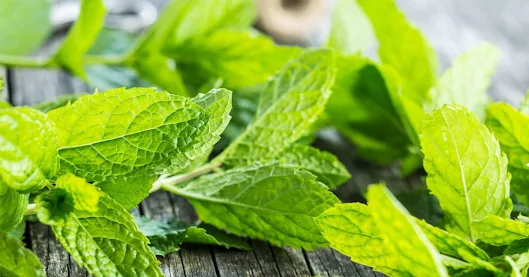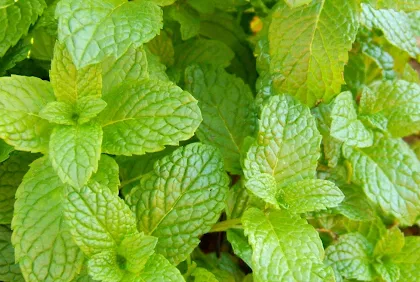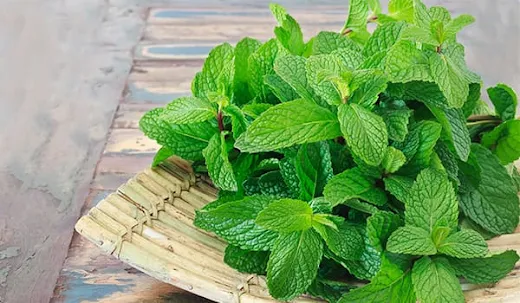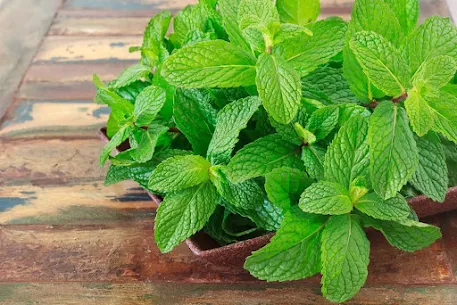Top 22 Medicinal Uses of Mint Leaves (No.9 Shocking)
Some types of mint leaves like as Mentha piperita L, Mentha arvensis L, and Menta spicata (spearmint) are often cultivated to produce essential oils that used for the purpose of making liquor and confectionary industry, spices, perfume production, and as treatment. Besides being very useful for that purpose, mint leaves can also be used as a repellent or insect repellent because it contains essential oils which are substances that are not favored by insects. The Mint family consists of about 4000 species, which spread almost all over the world. Most oil-containing aromatic mint leaves are in the stems and leaves.
- Mint leaves classification
- Nutrition facts of mint leaves
- Health benefits of mint leaves: As a Prevention, As A Treatment and beauty
- Warning: side effect of mint leaves for certain people
- Recommended dose
Mint Leaves Classification
In the disciplines of biology, known grouping system living organisms including plants called classification. Mint classification as follows:
Kingdom: Plantae
Division: Magnoliophyta
Class: Magnoliopsida
Order: lamiales
Family: Lamiaceae
Genus: Mentha
Nutrition Facts Of Mint Leaves (spearmint types)
Calories 44.0 (184 kJ) or 2% Daily Values (DV) come from Carbohydrate 29.9 (125 kJ), From Fat 6.1 (25.5 kJ), From Protein 8.0 (33.5 kJ), and From Alcohol (0.0 kJ);
Total Carbohydrate 8.4g or 3% DV come from Dietary Fiber 6.8g or 27% DV;
Total Fat 0.7g or 1% DV comes from Saturated Fat 0.2g or 1% DV, from Monounsaturated Fat 0.0g, from Polyunsaturated Fat 0.4g, from Total Omega-3 fatty acids 338mg and from Total Omega-6 fatty acids 54.0mg;
ALSO READ: 10 Health Benefits of Pumpkin Leaves You Should Know
Protein 3.3g or 7% DV;
Vitamin, from Vitamin A 4054IU or 81% DV, Vitamin C 13.3mg or 22% DV, Thiamin 0.1mg or 5% DV, Riboflavin 0.2mg or 10% DV, Niacin 0.9mg or 5% DV, Vitamin B6 0.2mg or 8% DV, Folate 105mcg or 26% DV and Pantothenic Acid or 0.3mg or 3%;
Minerals, from Calcium 199mg or 20% DV, Iron 11.9mg or 66% DV, Magnesium 63.0mg or 16% DV, Phosphorus 60.0mg or 6% DV, Potassium 458mg or 13% DV, Sodium 30.0mg or 1% DV, Zinc 1.1mg or 7% DV, Copper 0.2mg or 12% DV, Manganese 1.1mg or 56% DV;
Sterols, from Cholesterol 0.0mg and from Phytosterols 10.0mg
Water 85.6g and Ash 2.0g.
Note: Percent Daily Values (%DV) are for adults based on a 2,000 calorie reference diet. Your daily values may be higher or lower.
Medicinal Uses of Mint Leaves
Mint leaves have a fragrant aroma and refreshing cool taste. The scent of mint leaves caused volatile oil content in the form of menthol oil. This plant is one of the most popular herbs and most developed in the world. Mint leaves can also be utilized for additional cooking. This is because the mint has a sweet taste and also a cool and refreshing sensation after eating. Consuming mint leaves are effectively able to prevent and treat:
Muscle ache. Mint leaves are also believed to be a drug used to treat pain in the body. For content in it are antispasmodic. This substance very well works to loosen your muscles is tensed. So it is suitable to cope with muscle pain in the body.
Bad Smells of breath. The fresh mint flavor makes it ideal to relieve bad Smells of breath odors. Mint tea made from fresh mint leaves or dried effectively gets rid of bacteria that cause bad smells of breath. Mint will also keep the mouth moist by stimulating saliva production.
Many people claim that they are addicted with the food which served to contain mint. The flavors were given a refreshing effect and a comfortable for the audience.
Mint is able to relieve heartburn through antispasmodic and by increasing the flow of digestive fluids through the digestive system. But be careful with large doses of mint because it can worsen heartburn symptoms. Drink no more than three or four cups of mint tea every day. Never swallow pure mint oil.
Nasal congestion. Plant mint contains menthol, ingredients commonly used in the commercial drugs of the flue. The smell of menthol can help open the respiratory tract because it contains anti-inflammatory properties. The antibacterial properties of mint leave also help treat infections due to bacterial attacks. Mint loosens bronchial constriction.
Nausea and indigestion. Mint in capsule form or prepared as tea to relieve nausea and indigestion. It has the potential to the digestive system and relieves stomach cramps. Mint has a mild anesthetic effect so as to relieve pain in the stomach. The Journal of Advanced Nursing showed that the mint leaves as an anti-nausea drug post-surgery. Mint can be used as a nausea reliever and menstrual cramps.
Overcoming fever. One effect of mint is providing a sense of cold, refreshing to the body. Even those who have a fever or a temperature rise, typically use mint to relieve the heat. (Typhoid Fever: What is typhoid fever? Symptoms, Home Remedies For Typhoid Fever)
Oral health. Mint leaves have anti-bacterial. Chew mint leaves to fight harmful bacteria in the mouth, teeth, and tongue.
Preventing Cancer. Vitamin C and antioxidants in mint leaves is useful to counteract the free radicals cause all sorts of diseases one of which is cancer. Not only that, but the mint leaves are also rich in vitamin A and beta carotene which is very good for maintaining eye health.
Reduce stress. Mint gives the effect of extraction and tranquility for the audience. That is why mint is used as aromatherapy in the medical world. The content of antioxidants can be used against stress from the outside to your body. So your body becomes more calm and relaxed.
Improve Body Immune System. Immune function to prevent the disease into the body. Immunity will increase when a person is exercising regularly and eating foods rich in nutrients. Mint leaves contain vitamin C that can positively impact your immune system. Therefore, do not hesitate to add a mint leaf to a menu of food that you consume.
Itching in the throat. The content of the mint leaves is also very active to cure and relieve itchy throat that causes coughing. This is because there is some very good mint composition for the open cavity on the nose.
Overcoming Allergies. Mint leaves are excellent in controlling allergic skin. For those who often suffer from skin allergies, you should try to add a mint leaf to the food they consume. This is because the mint has a substance that can help in controlling and eliminating fungus and bad bacteria. Given that control allergy that will attack the skin become more controllable.
Eye health. The content of mint also contained vitamin A. One of its functions is to maintain health and eye care. Even those who had the disorder or start myopic were encouraged to continue to consume foods that contain lots of vitamin A, one with mint and carrot.
Maintain healthy skin. Mint leaves contain vitamins E and D are very good for maintaining healthy skin. In this case, used to help renew dead skin or skin that is not good. Besides the benefits of salicylic acid, this is very useful in the process of the replacement of skin cells that have been damaged. So that the skin is growing thereafter become healthier and appear fresh.
Acne is a skin problem that is often experienced by everyone. To fix it we could mix the mint leaves with rose water. Then apply on the face. Let stand for a few minutes and then rinse. To get the maximum results you need to do this treatment regularly.
Refreshes the scalp. Mint leaves can also be used as herbal medicine to overcome and refresh scalp irritation. To be more optimal benefits, you can use mint leaves directly by taking a few leaves of mint, knead until smooth, and then applying on the scalp. The menthol in mint can give refreshing to your scalp.
Overcoming Abusive heel. If your heel coarse try to overcome this problem by soaking the foot in warm water that has been mixed with mint leaves. In this way, the rough skin on the heels can be lost slowly.
Coping lice. To cope with fleas, you can use mint oil at least 3-4 times a week. In addition to reducing itching can also eliminate head lice.
Eliminate mosquito bites. Inflammatory nature contained in mint leaves can help to overcome the mosquito bite. The itching caused by mosquito bites can be eliminated by attaching a mint leaf in part bitten.
READ MORE: 12 Powerful Health Benefits Of Coriander Leaves
Warning: side effect of mint leaves for certain people
It’s very important for us to know how the following side effects of using mint leaves.
People with gastroesophageal reflux disease (GERD), Do not use mint in an attempt to soothe digestive problems if the symptoms are associated with gastroesophageal reflux disease (GERD); mint can worsen this condition.
For people with a history of gallstones, use mint carefully and consult a physician beforehand.
On baby, do not apply mint oil to his face, because it can lead to seizures that inhibit breathing.
Pregnant or breastfeeding should avoid the consumption of mint tea because consuming it can cause miscarriage.
Mint leaves if taken in large doses, can be toxic. pure menthol is toxic and should not be taken internally.
To avoid the negative effects of mint must be applied to the appropriate dose. Here is the prescribed dosage:
If it is used as a beverage such as mint leaves Tea: Soak 1 teaspoon dried mint leaves in a cup, boiling water for at least ten minutes and let cool. Drink this two to three times daily between meals.
If it is used as a capsule, the recommended dose is 1 to 2 capsules three times a day to treat irritable bowel syndrome.
As the oil or ointment: Apply a cream or ointment containing active menthol to treat the skin irritation and itching.
Consumption of mint in the right amount is very important to get the benefits of this herb and avoid the side effects.






.jpg)






.jpeg)

